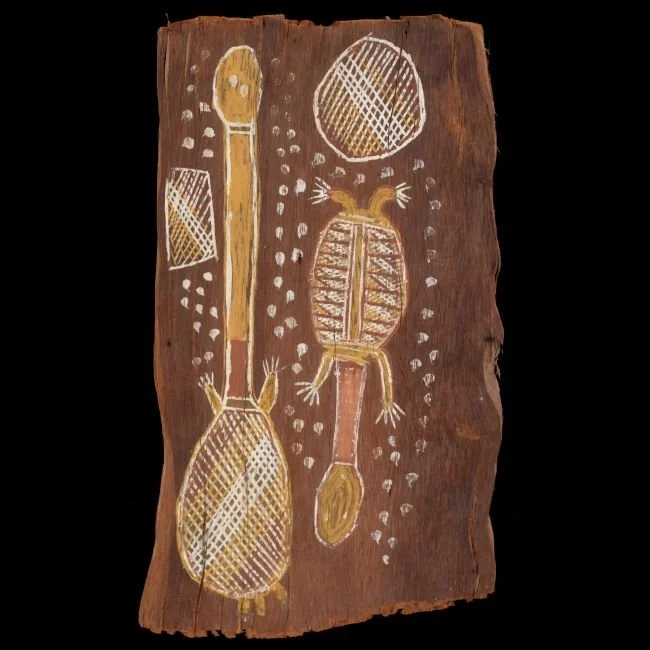
Artist: Peter Burarrwanga Datjin | Title: Untitled | Year: 2002 | Medium: natural ochres on canvas | Dimensions:
PROVENANCE
Galiwinku Arts Cat. No. 14/682/DAT
ARTWORK STORY
This is a sacred story about the Gumatj clan, their life and laws.
The painting depicts the Ganiny (said Gun ning), a sacred ceremonial item usually held by the clan leader while dancing. It is part of a sacred ceremony (generally a mortuary ceremony) belonging to the Yirritja people and is performed by men only. The ceremony is held under a paper bark tree, which is symbolic and an important part of the ceremony.
The white tips of the Ganiny represent the paper bark. This is also the same white clay that is painted on the forehead of the local Yolgnu (aboriginal people from Northeast Arnhem Land) for funerals and other ceremonies.
Use of the diamond design links the Yirritja clans to their ancestral sources in their dreaming. The diamonds can have many meanings and stories, it can represent water flowing, bees and honey, low tide, salt water pools or sacred fire (the Gumatj fire is linked back to the dreamtime).
The three small horizontal lines cutting into the Ganiny are representing the tidal rivers, the three Gumatj clans and the scars found on the chest of initiated elders, representing bravery.
The surrounding background crosshatching depicts the tides of the sea coming in and going out, depending on the angle.
Artist Profile
COMMUNITY/REGION
Elcho Island, NT
LANGUAGE
Gumatj
BIOGRAPHY
Peter Burarrwanga Datjin, born in 1953, is an esteemed Gumatj artist and ceremonial leader from Elcho Island in the Northern Territory. He is known for his detailed bark paintings, which often incorporate ochres and natural pigments. Peter’s art has been exhibited nationally, and he remains an influential figure within the Yolngu community.
PROVENANCE
Galiwinku Arts Cat. No. 14/682/DAT
ARTWORK STORY
This is a sacred story about the Gumatj clan, their life and laws.
The painting depicts the Ganiny (said Gun ning), a sacred ceremonial item usually held by the clan leader while dancing. It is part of a sacred ceremony (generally a mortuary ceremony) belonging to the Yirritja people and is performed by men only. The ceremony is held under a paper bark tree, which is symbolic and an important part of the ceremony.
The white tips of the Ganiny represent the paper bark. This is also the same white clay that is painted on the forehead of the local Yolgnu (aboriginal people from Northeast Arnhem Land) for funerals and other ceremonies.
Use of the diamond design links the Yirritja clans to their ancestral sources in their dreaming. The diamonds can have many meanings and stories, it can represent water flowing, bees and honey, low tide, salt water pools or sacred fire (the Gumatj fire is linked back to the dreamtime).
The three small horizontal lines cutting into the Ganiny are representing the tidal rivers, the three Gumatj clans and the scars found on the chest of initiated elders, representing bravery.
The surrounding background crosshatching depicts the tides of the sea coming in and going out, depending on the angle.
Artist Profile
COMMUNITY/REGION
Elcho Island, NT
LANGUAGE
Gumatj
BIOGRAPHY
Peter Burarrwanga Datjin, born in 1953, is an esteemed Gumatj artist and ceremonial leader from Elcho Island in the Northern Territory. He is known for his detailed bark paintings, which often incorporate ochres and natural pigments. Peter’s art has been exhibited nationally, and he remains an influential figure within the Yolngu community.






